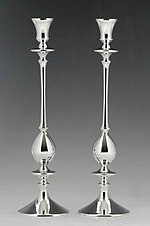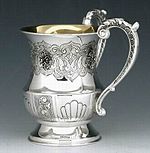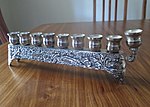Jewish ceremonial art



Jewish ceremonial artis objects used byJewsfor ritual purposes. Because enhancing amitzvahby performing it with an especially beautiful object is considered a praiseworthy way of honoring God's commandments, Judaism has a long tradition of commissioning ritual objects from craftsmen and artists.[1]
Jewish ceremonial art forms a large part ofJudaica(/dʒuːˈdeɪ.ɪkə/), a general academic and art trade term for Jewish-related objects, of which other types aremanuscripts,books and other printed materials, artworks in various media, and clothing.
Textual origin
[edit]Multiple early rabbinic commentaries on theHebrew Biblerefer to sanctifying rituals with visually pleasing objects in theMidrash.MidrashMekhilta of Rabbi Ishmaelhas this teaching on a biblical verse:
"This is my God and I will glorify Him" (Exodus 15:2)
Is it possible for a human being to add glory to his Creator? What this really means is: I shall glorify God in the way that I perform commandments. I shall prepare a beautifullulav,beautifulsukkah,beautiful fringes (tzitzit), and beautifultefillin.[citation needed]
Other Midrash teachings (e.g.Shir HaShirim Rabbah1.15) offer the same idea. This idea is expanded upon in theBabylonian Talmud(e.g.Bāḇā Qammā9b). This teaching was understood by succeeding generations as a duty, when possible, to make beautiful items used in Jewish life and worship, both physical and textual.
Items used on Shabbat
[edit]
The following items are used during Shabbat:
- Kiddush cup:Kiddush,literally, "sanctification", is a blessing recited overwineorgrape juiceto sanctify theShabbatandJewish holidays.Kiddush cups are highly decorated, and are generally made of china, porcelain, silver, pewter and nickel.
- Shabbat candlestick holders
- Hand washing cup ( "netilat yediam" )
- Challah cutting board and cover
- Havdalah candle and candle holder
- Havdalah spice box
The end of the JewishShabbatis marked by the brief prayer ceremony ofHavdalah,which usually takes place in the home. Part of the ceremony requires sniffing a sweet-smelling spice or plant. In Jewish communities around the Mediterranean, a sprig of a sweet-smelling shrub was customarily used, in Northern Europe by the twelfth century there are literary references of the use of a specially designed spice box or container. The oldest surviving spice boxes for Havdalah date to the mid-sixteenth century. TheJewish Museum (New York)has a German examplec. 1550thought to originate inFrankfurt am Main.[2]
Hanukkah items
[edit]
Themenorah(or hanukkiah) used on the Jewish holiday ofHanukkahis perhaps the most widely produced article of Jewish ceremonial art.[3][4][5]TheLindo lampis a particularly fine example by an 18th-century silversmith. Contemporary artists often design menorahs, such as the gold-plated brass menorah with 35 moveable branches designed byYaacov Agam.[6]A silver menorah byZe'ev Rabanfrom the 1930s is in the Judaica Collection of theNorth Carolina Museum of Art.[7]
- Chanukah menorah
- Dreidels
- Gelt holder
- Chanukah candles or Oil
Sukkot items
[edit]
- Esrog Box
To protect theesrogduring theSukkotholiday, it is traditionally wrapped in silky flax fibers and stored in a special box, often made from silver.[8]
In modern times, the esrog is also commonly wrapped in synthetic netting, and placed in cardboard boxes. Wooden boxes are increasingly popular as well.
Books
[edit]Passover haggadah
[edit]The tradition of artistically embellishedhaggadahs,the Jewish text that sets forth the order of thePassover Seder,dates back to the Middle Ages. TheSarajevo Haggadahof 1350 is a celebrated example. Major contemporary artists have produced notable haggadahs, such as theSzyk Hagaddah.See also the facsimile edition of the even earlier Barcelona Haggadah[9]of 1340.
Notable Judaica collections
[edit]Museums with notable collections of Jewish ceremonial art include theBritish Library,[10]theIsrael Museum,theJewish Museum (London),theMusée d'Art et d'Histoire du JudaïsmeinParis,theJewish Museum in Prague,theNorth Carolina Museum of Art,[7]theJewish Museum (New York),theMusée LorraininNancy,[11]theMusée alsacieninStrasbourgand theContemporary Jewish MuseumofSan Francisco.[12]TheMuseum of Jewish Heritagein Battery City Park, New York City also holds a sizable collection. Another way to see Judaica is through the art marketplace, including auction houses. Sotheby's, Bonhams-New York, Skinner's and Kestenbaums routinely hold regular auctions each year.
See also
[edit]Other items
[edit]- Mizrach,object indicating the direction of prayer
- Parochet,curtain of the Torah Ark
- Shiviti,meditative text
References
[edit]- ^Kanof, Abram (1982).Jewish Ceremonial Art and Religious Observance.New York: Abrams.ISBN9780810921993.
- ^"Spice Container".The Jewish Museum. thejewishmuseum.org. Retrieved 2016-12-23.
- ^Luminous Art: Hanukkah Menorahs of The Jewish Museum, Susan L. Braunstein, Jewish Museum, New York, 2004
- ^Lighting the Way to Freedom: Treasured Hanukkah Menorahs of Early Israel, Aaron Ha'tell, Yaniv Ben Or, Devora Publishing (November 29, 2006)
- ^Berman, Nancy M. (2016).The Art of Hanukkah.Universe Publishing.ISBN9780789332516.
- ^"Agam Brass Menorah".herndonfineart.Archived fromthe originalon 2016-12-23.Retrieved2009-07-30.
- ^ab"Mending Wounds in the Judaic Collection – North Carolina Museum of Art | Untitled".Archived fromthe originalon May 15, 2009.
- ^"Redirecting..."aish.26 January 2003. Archived fromthe originalon 1 March 2020.Retrieved4 October2011.
{{cite web}}:Cite uses generic title (help) - ^"Facsimile Editions - Barcelona Haggadah".facsimile-editions.
- ^"The Barcelona Haggadah: Haggadah, liturgical poems and biblical readings for Passover, Sephardic rite".British Library.
- ^Les Juifs et la Lorraine, un millénaire d'histoire partagée,Musée Lorrain, Nancy; Somogy – Éditions d'Art, 2009, p. 164; this collection is temporarily not on public display in 2017.
- ^"The CJM - The Contemporary Jewish Museum".thecjm.org.
